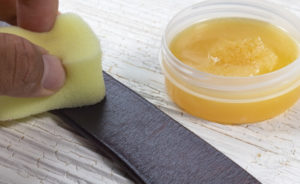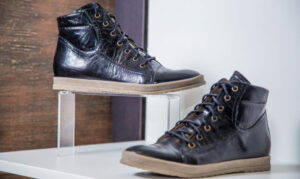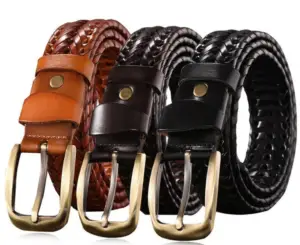Effects of using too much neatsfoot oil on leather
If you’ve ever applied too much neatsfoot oil on leather goods like boots and shoes, you know the end result is not pretty.
The leather can become sticky and greasy, and attract dirt and dust. In extreme cases, the neatsfoot oil can actually cause the leather to rot. So how do you avoid this problem?
In this article, we shall look at the effects of over-oiling your leather items. We shall also discuss how you can prevent them from getting damaged when you accidentally use too much oil.

What happens when you use too much neatsfoot oil on leather?
Neatsfoot oil is great for leather as it helps to condition and protect by making leather waterproof. However, too much of it can cause problems such as;
-
Breaks down leather fibers
Neatsfoot oil is a natural product made from rendered animal fats, and over-application can indeed lead to leather breakdown and rotting over time. This is because the oil can break down the fibers in leather, causing it to deteriorate faster than usual.
-
The leather becomes extremely soft and loses shape
Another effect of applying too much oil to leather is that it makes the products too soft due to the breakdown of the fibers.
As a result, the leather starts to stretch or sag over time and eventually loses its original shape. This usually happens with leather shoes and boots.
-
Causes leather to darken
While neatsfoot oil is not known to discolor leather products, applying too much of it can actually cause more damage than good.

This is because the oil will clog the pores in the leather and prevent breathability and thereby causing the leather to darken.
-
Weakens the stitches
Using a lot of neatsfoot oil or mink oil can ruin leather in that it can degrade the stitching on your leather belts, shoes, or boots.
It weakens and causes the stitching to break down or rot over time.
That is why you should never dip your leather items in oil as it can ruin them. Simply apply a light coat of oil on the surface and avoid getting it on the stitching.
In addition, keep an eye on the condition of your stitches, inspecting them regularly for signs of wear and tear.
If you notice any fraying or breaking, take your shoes or boots to a cobbler for repairs before continuing to wear them.
-
Shoes tear at stress points
Neatsfoot leather oil helps to keep leather shoes and boots supple and prevents them from drying out and cracking over time.
Hence, it’s quite effective at penetrating the leather and keeping it hydrated.
However, it’s important not to go overboard with the oil, as too much can weaken the leather and make your items more prone to tearing especially at the stress points.
-
Leather feels greasy
Neatsfoot oil it can cause the material to become greasy and slippery. So it’s important to use it sparingly and to test it on a small area of the leather first before applying it all over.
-
Possibility of mold and mildew growth
If you apply a lot of neatsfoot oil to your leather products, you run the risk of mold and mildew growth.
This is because the oil clogs the pores of the leather and prevents it from breathing, which leads to a build-up of moisture.
Mold thrives in moist and dark conditions so if you don’t dry your leather adequately, the environment will be good enough for mold and mildew to grow.
How to remove excess neatsfoot oil from leather
If you’ve applied too much neatsfoot oil and your leather now looks darker and duller in color, don’t panic. There are a few easy ways to fix this.
Method 1: Wipe off excess oil before it soaks in
First, try dabbing the excess oil off with a clean cloth. Then, use another clean cloth to apply a small amount of talcum powder or cornstarch to the shoes. This will help absorb any remaining oil and give the leather a matte finish.
If your leather still looks a little too oily, try wiping it down with a dryer sheet to give it a nice polished appearance.
Did this work? If not, try this second method below.
Method 2: Wash out the oil
If the above method doesn’t work, then gently rub some saddle soap into the leather to help lift off the excess oil. Once you’re finished, buff the leather with another clean cloth until it shines.
Alternatively, you can remove excess leather oil using hot water and a clean cloth or sponge. First, wet the cloth or sponge in hot water and then wring it out until it’s damp.
Next, gently wipe down the affected areas of your leather clothing or shoes. Be sure to avoid scrubbing too hard, as this can damage the leather items. Finally, dry with a clean towel and air dry.
If the oil has already soaked into the leather, you may have to use a pressure washer. Just be sure to use a high-pressure setting and aim the nozzle at the oily areas. You may need to repeat the process a few times to get all of the oil off.
However, be careful when using the hot water and pressure washer method as it may get the work done but cause your leather to harden.
Method 3: Lighten the leather
When oxalic acid is mixed with water, it can be used to lighten leather safely.
So, if neatsfoot caused your leather to darken, you can use oxalic acid to lighten it by following these steps:
1. Dilute the oxalic acid with water in a ratio of 1:3
2. Dip a cloth into the diluted oxalic acid and apply it to the stained area of the leather.
3. Leave the oxalic acid on the leather for about 15 minutes.
4. Wipe away any excess oxalic acid with a damp cloth and rinse thoroughly. Repeat if necessary.
Be careful when using oxalic acid to lighten your leather because it can cause damage if used improperly.
How to apply neatsfoot oil on leather the right way
- First, it’s important to understand that a little neatsfoot oil goes a long way. You only need a small amount to condition and protect your leather.
- Second, be sure to apply the oil evenly over the surface of the leather. Applying too much oil in one area will cause problems.
- Finally, don’t forget to buff the leather after applying the neatsfoot oil. This will help to spread the oil evenly and give your leather a nice shine.
Following these simple tips, you can enjoy all the benefits of neatsfoot oil without damaging your leather goods.
So, is neatsfoot oil bad for leather?
Neatsfoot oil is not necessarily bad for leather, but it can be if overused.
Leather is a natural product and needs some sort of oil to help it retain its softness and flexibility.
Neatsfoot oil is a popular choice for this because it is affordable and easy to find.
However, overusing neatsfoot oil can leave a sticky residue on the leather that will attract dirt and dust. It can also make the leather weaken and become too soft causing it to deteriorate faster.
So, only use the recommended amount and avoid over-oiling your leather goods or you can try other leather oil alternatives.
How long does it take for neatsfoot oil to dry?
It can take up to 24 hours for neatsfoot oil to dry. You may want to speed up the process by using a hairdryer on a low setting.
Does neatsfoot oil dry out leather?
Neatsfoot oil is a common treatment for leather, and it has been in use for centuries.
Some people believe that neatsfoot oil will dry out the leather and opt for alternatives but there is no scientific evidence to support this claim.
Leather is a natural product, and it contains oils that help keep it soft and flexible. When leather dries out, it becomes stiff and brittle.
The purpose of neatsfoot oil is to replace the natural oils that have been lost, which will help keep the leather soft and flexible.
Neatsfoot oil will not dry out the leather, but it may make the leather a little bit oily.
Conclusion
If you’re a fan of leather goods, you’ve probably heard of neatsfoot oil.
This natural oil is often used to condition and preserve leather, giving it a softer feel and longer lifespan.
However, it’s important to use neatsfoot oil in moderation. Applying too much oil to leather can actually cause problems like rot and deterioration.
Always use only the recommended amount, and test a small area of leather before applying it more broadly. If in doubt, it’s best to consult with a professional who specializes in caring for leather items.




